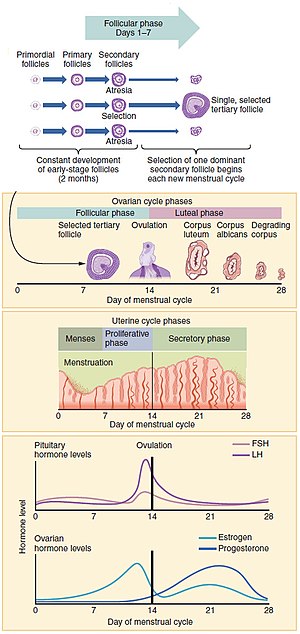User:Mr. Ibrahem/Menstruation

Menstruation, also known as a period or monthly,[1] is the regular discharge of blood and mucosal tissue (known as menses) from the inner lining of the uterus through the vagina.[2] The first period usually begins between twelve and fifteen years of age, a point in time known as menarche.[1] However, periods may occasionally start as young as eight years old and still be considered normal.[2] The average age of the first period is generally later in the developing world, and earlier in the developed world.[3] The typical length of time between the first day of one period and the first day of the next is 21 to 45 days in young women, and 21 to 31 days in adults (an average of 28 days).[2][3] Bleeding usually lasts around 2 to 7 days.[2] Menstruation stops occurring after menopause, which usually occurs between 45 and 55 years of age.[4] Periods also stop during pregnancy and typically do not resume during the initial months of breastfeeding.[2]
Up to 80% of women report having some symptoms prior to menstruation.[5] Common signs and symptoms include acne, tender breasts, bloating, feeling tired, irritability, and mood changes.[6] These may interfere with normal life, therefore qualifying as premenstrual syndrome, in 20 to 30% of women.[5] In 3 to 8%, symptoms are severe.[5]
A lack of periods, known as amenorrhea, is when periods do not occur by age 15 or have not occurred in 90 days.[2] Other problems with the menstrual cycle include painful periods and abnormal bleeding such as bleeding between periods or heavy bleeding.[2] Menstruation in other animals occur in primates (apes and monkeys).[7][8]
The menstrual cycle occurs due to the rise and fall of hormones.[2] This cycle results in the thickening of the lining of the uterus, and the growth of an egg, (which is required for pregnancy).[2] The egg is released from an ovary around day fourteen in the cycle; the thickened lining of the uterus provides nutrients to an embryo after implantation.[2] If implantation does not occur, the lining is released in what is known as menstruation.[2]
References[edit]
- ^ a b Women's Gynecologic Health. Jones & Bartlett Publishers. 2011. p. 94. ISBN 9780763756376. Archived from the original on 26 June 2015.
- ^ a b c d e f g h i j k "Menstruation and the menstrual cycle fact sheet". Office of Women's Health. 23 December 2014. Archived from the original on 26 June 2015. Retrieved 25 June 2015.
- ^ a b Diaz A, Laufer MR, Breech LL, American Academy of Pediatrics Committee on Adolescence, American College of Obstetricians and Gynecologists Committee on Adolescent Health (November 2006). "Menstruation in girls and adolescents: using the menstrual cycle as a vital sign". Pediatrics. 118 (5): 2245–50. doi:10.1542/peds.2006-2481. PMID 17079600.
- ^ "Menopause: Overview". nichd.nih.gov. 28 June 2013. Archived from the original on 2 April 2015. Retrieved 8 March 2015.
- ^ a b c Biggs WS, Demuth RH (October 2011). "Premenstrual syndrome and premenstrual dysphoric disorder". American Family Physician. 84 (8): 918–24. PMID 22010771.
- ^ "Premenstrual syndrome (PMS) fact sheet". Office on Women's Health. 23 December 2014. Archived from the original on 28 June 2015. Retrieved 23 June 2015.
- ^ Kristin H. Lopez (2013). Human Reproductive Biology. Academic Press. p. 53. ISBN 9780123821850. Archived from the original on 21 June 2015.
- ^ Martin RD (2007). "The evolution of human reproduction: a primatological perspective". American Journal of Physical Anthropology. Suppl 45: 59–84. doi:10.1002/ajpa.20734. PMID 18046752.
